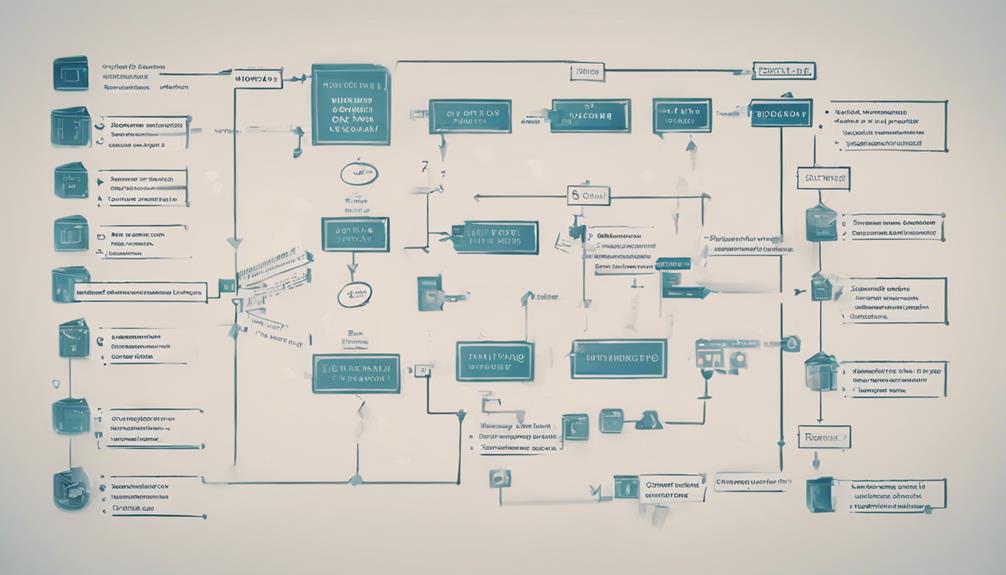When aiming to streamline your order processing services, identifying and resolving inefficiencies is crucial. By optimizing your workflow and embracing automation where applicable, you can enhance operational efficiency significantly. However, the key lies not only in the initial changes but also in the ongoing monitoring and adaptation to ensure sustained improvement. Stay tuned to discover practical strategies for transforming your order processing into a seamless and efficient operation that elevates both productivity and customer satisfaction levels.
Identify Inefficiencies
To improve order processing services, begin by identifying inefficiencies in the current system. Conducting an efficiency analysis is crucial for process improvement. Start by mapping out the workflow to pinpoint areas that are causing bottlenecks or delays. Look for redundant steps or manual tasks that could be automated to streamline the process. Workflow optimization is key to implementing time-saving strategies.
Consider the different stages of order processing, from order entry to fulfillment, and evaluate the efficiency of each step. Are there communication gaps between departments that slow down the process? Is data being entered multiple times, leading to errors and wasted time? By identifying these inefficiencies, you can prioritize areas for improvement.
Utilize tools like process mapping, time tracking, and employee feedback to gain insights into where the system can be optimized. Engage employees who are directly involved in order processing to gather their input on pain points and potential solutions. By focusing on efficiency analysis and process improvement, you can lay the foundation for a more streamlined order processing system.
Brainstorm Solutions
To streamline order processing services effectively, start by pinpointing bottlenecks in the current process. Look into automating repetitive tasks wherever possible to save time and increase efficiency. Consider implementing a tracking system to monitor orders and ensure smooth flow throughout the entire process.
Identify Bottlenecks in Process
Identify potential bottlenecks within your order processing system by conducting a thorough analysis of each stage in the process. To streamline workflow and optimize resources, start by mapping out the entire order processing journey from the moment an order is received to its fulfillment. Look for stages where delays commonly occur, such as manual data entry, approval processes, or inventory checks. By identifying these bottlenecks, you can pinpoint areas that need improvement.
Once you’ve pinpointed the bottlenecks, brainstorm solutions to address them. This could involve implementing automation tools to speed up repetitive tasks, reallocating resources to high-impact areas, or redesigning processes to reduce unnecessary steps. Consider utilizing technology like order management systems to centralize data and streamline communication between departments. Additionally, training your staff on efficient order processing techniques can also help alleviate bottlenecks and improve overall efficiency.
Regularly monitoring and evaluating your order processing system will ensure that any new bottlenecks are quickly identified and addressed, allowing for a smoother and more efficient workflow.
Automate Repetitive Tasks
Consider automating repetitive tasks within your order processing system to optimize efficiency and reduce manual workload. Efficiency improvement can be achieved through the implementation of workflow automation tools that streamline routine processes. Start by identifying tasks that are repetitive and time-consuming, such as data entry, order confirmation emails, or inventory updates. These tasks can often be automated using software solutions specifically designed for order processing.
Workflow automation allows for seamless integration between different stages of order processing, eliminating the need for manual intervention at each step. By setting up automated workflows, you can ensure that orders move swiftly from placement to fulfillment without unnecessary delays. This not only speeds up the entire process but also minimizes the risk of errors that can occur with manual handling.
Investing in automation tools tailored to your order processing needs can lead to significant time and cost savings in the long run. Additionally, it frees up your team to focus on more strategic tasks that require human input, ultimately enhancing overall operational efficiency.
Implement Tracking System
Explore implementing a robust tracking system into your order processing services to enhance visibility and efficiency throughout the entire fulfillment process. By incorporating a tracking system, you can significantly improve accountability by easily monitoring the status and progress of each order. This increased transparency allows for better decision-making and resource allocation, leading to smoother operations.
Enhancing communication is another key benefit of a tracking system. It enables real-time updates that can be shared internally with team members or externally with customers, ensuring everyone is on the same page. This not only fosters a more collaborative environment but also builds trust with your clients.
Moreover, implementing a tracking system helps ensure accuracy in order processing. With detailed information about each order’s journey, you can identify and address any potential errors or bottlenecks promptly. This proactive approach minimizes mistakes and streamlines the fulfillment process, ultimately enhancing customer satisfaction.
Implement Changes
How can the current order processing system be modified to incorporate the necessary changes efficiently? To enhance workflow optimization and improve efficiency, start by analyzing the existing processes to identify bottlenecks and areas for improvement. Consider integrating automated tools or software solutions to streamline repetitive tasks and enhance process efficiency. Implement changes gradually to minimize disruptions, ensuring a smooth transition for your team.
Process enhancement is key to achieving a more streamlined order processing system. Look for ways to simplify complex procedures, eliminate redundant steps, and standardize workflows. By integrating these changes, you can reduce errors, speed up order fulfillment, and enhance overall productivity.
System integration plays a crucial role in streamlining order processing services. Ensure that different systems used in the process communicate effectively with each other to avoid manual data entry duplication. Consider adopting a centralized platform that consolidates all order-related information for easier access and management. By integrating systems seamlessly, you can create a more efficient and cohesive order processing environment.
Train Staff
To enhance the efficiency of your order processing system, providing comprehensive training to your staff on the new processes and tools is essential. Staff engagement is crucial during this phase to ensure that everyone understands the changes and is motivated to adapt. Performance improvement should be at the core of your training program, focusing on enhancing skills and knowledge that directly impact order processing speed and accuracy.
Encourage team collaboration throughout the training process. This can be achieved through group exercises, role-playing scenarios, or team-building activities. By fostering a collaborative environment, employees can learn from each other, share best practices, and work together more effectively.
Communication strategies play a vital role in ensuring that information is effectively conveyed during training sessions. Clear and concise instructions, regular updates, and open channels for feedback are key components of successful training. Encourage questions and discussions to address any uncertainties promptly. By investing time and effort into training your staff thoroughly, you pave the way for a more streamlined and efficient order processing system.
Monitor Progress
You can effectively monitor the progress of order processing by tracking order status, receiving real-time updates, and utilizing progress reporting tools. These methods allow you to stay informed about the status of each order, make quick decisions based on real-time data, and generate comprehensive reports for analysis. Implementing these monitoring techniques will streamline your order processing services and enhance efficiency.
Tracking Order Status
Efficiently track the progress of orders by utilizing the integrated monitoring system within the order processing services. This system plays a crucial role in improving communication and enhancing visibility throughout the order fulfillment process. By tracking the order status, you gain real-time insights into where each order stands, allowing you to proactively address any delays or issues that may arise.
Through the tracking feature, you can easily identify bottlenecks or inefficiencies in the order processing workflow. This visibility enables you to make informed decisions to streamline operations and ensure timely delivery of products to customers. The ability to monitor progress also facilitates better coordination between different departments involved in order fulfillment, fostering a more cohesive and efficient workflow.
Utilizing the tracking system not only benefits internal operations but also enhances customer satisfaction. With the ability to provide accurate and up-to-date information on order status, you can keep customers informed every step of the way, building trust and loyalty. Overall, tracking order status is a fundamental aspect of optimizing order processing services.
Real-Time Updates
Utilize the real-time monitoring feature to track progress seamlessly within the order processing system. This tool allows you to stay updated on the status of each order in real-time, ensuring efficient management of tasks. Through data analysis, you can identify trends, potential bottlenecks, and areas for improvement within the order processing workflow. By monitoring progress in real-time, you can proactively address any issues that may arise, leading to smoother operations.
Customer feedback plays a crucial role in real-time updates. By integrating customer feedback into the monitoring process, you can quickly address any concerns, make necessary adjustments, and enhance the overall customer experience. This real-time feedback loop enables you to adapt promptly to changing customer needs and preferences, fostering stronger relationships with your clientele.
Incorporating data analysis and customer feedback into your real-time monitoring strategy ensures that you have a comprehensive understanding of your order processing system. This approach allows for continuous improvement, increased efficiency, and ultimately, higher customer satisfaction.
Progress Reporting Tools
To enhance your order processing system further, implement progress reporting tools that allow you to monitor the status of tasks efficiently. These tools are crucial for effective time management and ensuring customer satisfaction. Here’s how progress reporting tools can benefit your business:
- Real-time Tracking: Keep track of each order’s progress in real-time, allowing you to promptly address any delays or issues that may arise.
- Performance Analytics: Gain insights into the efficiency of your order processing system, identify bottlenecks, and make data-driven decisions to streamline operations.
Gather Feedback
Collect feedback from customers and stakeholders to gain valuable insights into the order processing services. Customer satisfaction is a key aspect that can be improved by actively seeking feedback. Implementing strategies to gather feedback can help in understanding the pain points and areas of improvement in the order processing system. Conducting regular feedback analysis allows for the identification of trends and patterns that can be utilized for process optimization. By listening to the voices of customers and stakeholders, you can tailor your order processing services to meet their specific needs and preferences.
Feedback analysis is essential for making data-driven decisions to streamline the order processing services effectively. Look for recurring themes in the feedback received, and prioritize areas that require immediate attention. Understanding the feedback loop is crucial in maintaining a high level of customer satisfaction. By actively engaging with feedback and making necessary adjustments, you can optimize the order processing services to enhance overall efficiency and customer experience.
Make Adjustments
To improve the efficiency of order processing services, begin implementing adjustments based on feedback analysis and identified areas for optimization. Making strategic changes can significantly enhance your overall operations. Here are some key adjustments to consider:
- Improve Communication: Enhancing communication channels between different departments and teams can streamline the flow of information, reduce errors, and speed up the order processing cycle.
- Enhance Technology: Investing in advanced order processing software or upgrading your current systems can automate tasks, provide real-time data insights, and improve overall accuracy.
Frequently Asked Questions
How Do I Calculate the Return on Investment for Streamlining Order Processing?
To calculate return on investment for streamlining order processing, start by conducting a cost analysis to measure expenses saved. Then, use efficiency metrics like processing time reduction to quantify benefits. Compare the results to determine the ROI.
What Are the Best Software Options for Automating Order Processing?
When considering software for automating order processing, look for integration options like seamless connections with existing systems, user-friendly interfaces for easy navigation, customization features to tailor to your needs, and scalability benefits to grow with your business.
How Can I Ensure Data Security During the Order Processing Transition?
To ensure data security during the order processing transition, implement robust cybersecurity measures. Utilize data encryption to safeguard sensitive information. Regularly update security protocols. Train staff on best practices. Conduct audits to identify vulnerabilities. Stay vigilant against potential threats.
Are There Any Legal Implications to Consider When Making Changes?
When making changes, compliance considerations are crucial. Ensure you’re aware of legal implications to prevent risks. Implement robust risk management strategies to safeguard your business. Take proactive steps to stay compliant and protect your operations.
How Can I Maintain Customer Satisfaction While Streamlining Processes?
To maintain customer satisfaction while streamlining processes, prioritize clear customer communication. Implement process optimization gradually to minimize disruptions. Seek feedback from customers throughout the changes to ensure their needs are met and maintain high satisfaction levels.



